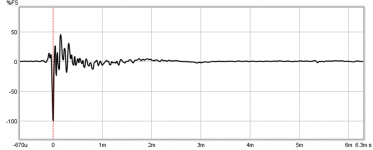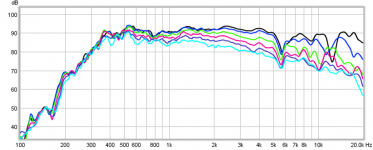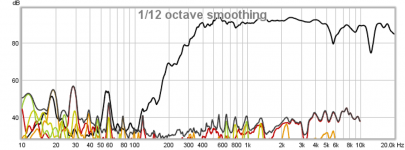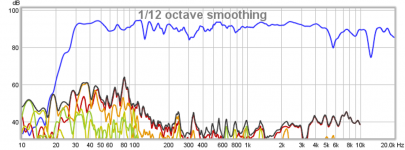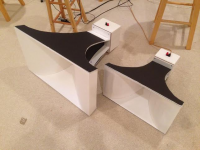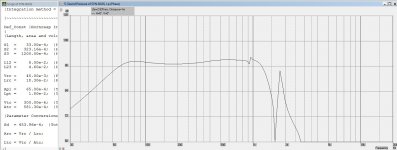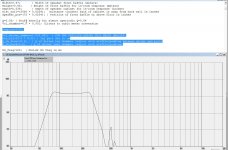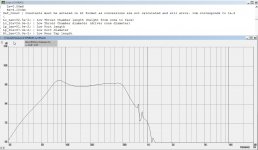Was thinking off sealed because of simplicity, but now you ask remind me i haven't thought of the wave distance between the two drivers center related to XO frequency, need to check.
Another question have rumbled you know always popped up when laying in bed but forgotten in daytime. A feature in your Nautaloss the good black hole that handle the backwave, would Tactrix horn benefit Nautaloss and black hole instead of ordinary sealed or is LF in horn too high a frequency to benefit this better backwave dampening.
I think that the peaks and ripples in the horn response far outweigh the improvements that the Nautaloss can provide in smoothness of the response in the horn. However, it may be useful if you have a horn response that is already very smooth and you want to color it with the back wave as little as possible, the use the Nautaloss for the rear chamber. I ran the tractrix with and without rear chamber and the HF were almost identical. So the effect intrinsic to the driver.
It can't hurt to use the Nautaloss for the rear chamber.
I am exploring the possibility of a smaller less expensive version of the tractrix horn but still with a similar killer performance. Not sure if possible until I build a prototype but if the sims hold up for this none like they did for the 5MR450NDY, it could be really interesting. The 0.7x scale provides a very manageable size of 20 in wide x 12 in tall x 15 in deep. This means that a single sheet of foam core can be used for the top and bottom panels, thus cutting foam core requirements in half. The horn should be able to provide about 400 Hz on the low end and upwards of 18kHz on the high.
Here is the predicted SPL at max thermal load of 40watts or 12v, cone displacement here is 0.9mm so xmax is still far off so HD should be very low:
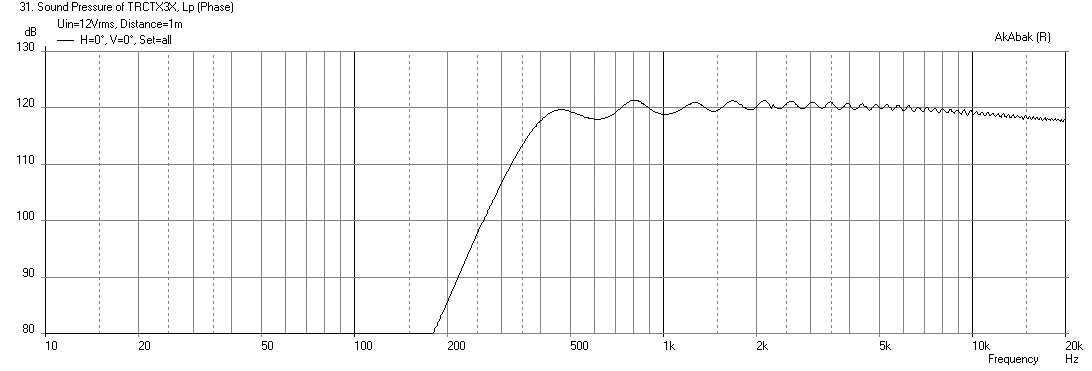
Sensitivity at 2.83v is about 108dB at 1m.
The best part is this driver only costs about $20. Anyone interested?
Why you get such wide bandwidth? if I do export to akabak I get not this respons, you do some extra in the script, can I have that to investicate.
Do you now in hornresp that VTC is the hole to the horn or not? because otherwise the space before the cone of the speaker is to big, or is ATC what I must consider throat chamber, some confusing here, I did hear VTC has to be divided by the number of ports in the horn.
thanks
kees
Kees,
I provided the code earlier - same one I only added scale of 0.7x to all dimensions. When you say you are exporting to AkAbak I assume that is a profile from HR? This wide bandwidth is only possible if you use a tractrix profile as prescribed by the Volvotreter spreadsheet. That is the profile in my script.
I provided the code earlier - same one I only added scale of 0.7x to all dimensions. When you say you are exporting to AkAbak I assume that is a profile from HR? This wide bandwidth is only possible if you use a tractrix profile as prescribed by the Volvotreter spreadsheet. That is the profile in my script.
Another to try:
The Madisound Speaker Store
Neat driver, I will give it a try in the sim. The inverted dome makes it easier to do an equidistant path phase plug.
Kees,
I provided the code earlier - same one I only added scale of 0.7x to all dimensions. When you say you are exporting to AkAbak I assume that is a profile from HR? This wide bandwidth is only possible if you use a tractrix profile as prescribed by the Volvotreter spreadsheet. That is the profile in my script.
Ahh oke.
I go get sheet and autocad for it.
Do now I want also tap woofers in it to get to 80 hz I did see in your script you have included even the tapped horn,
nice done.
thanks
kees
Kees,
You have an AkAbak model which has no ambiguity because every element is placed there by the user. I am no HR expert but I think the terms you are asking about are the driver front chamber volume is Vtc, and Atc is the chamber cross sectional area. Making Atc smaller implies a longer driver front chamber. If you just stick with the model in AkAbak you should be good. I don't see why you are jumping between the two. AkAbak is the more comprehensive software that can model multiple injection ports and combinations of different drivers at different locations in the horn - exactly what is needed to model a synergy.
I wil learn afcourse, that is one point and I am curieus about how it works with hornresp ports, you say akabak will work oke I agree but it is difficult software and I want also myself to test things and not to steal them.
The question was how it is with that room between cone and baffle/port, what counts for akabak will also be for hornresp because I have talk about the woofers not the cd of the horn.
I have play with your akabak script,, dit nice things but I have now the question of the volvotreter sheet, I did it and I get a very big horn when I try
to woofers on the sides, this is because this program see it as a ND horn type
like yours is, enneee the table for autocad, I did cannot copy and paste.
I go studie your script better, see if i can discover something.
I do react on your threat because it is better.
thanks for the help.
kees
0.70x scale Tractrix Build
I threw together another tractrix, this time at 0.70x scale of the first one. The dimensions ended up being 20 in wide x 12 in high x 15.8 in deep with a 1.95in square throat and a 2.3liter rear sealed chamber. Having done the first one provided lessons learned that made this one go very quickly - 4 hrs total. Also, the smaller size made it a lot faster to cut. The design is for a Faital Pro 3FE25, but while waiting for that driver to arrive, I thought why not try out the Vifa TC9FD? It is probably ill suited as a front horn driver with a very soft suspension and a rather weak motor for a high Qts of 0.89. Anyhow, I have them around so I stuck it in for grins. And it turns out not to sound so bad with some EQ'ing.
Here is a photo of the driver mounted onto the throat flange, I had to add a spacer to allow for the rubber half-roll surround to clear the flange:
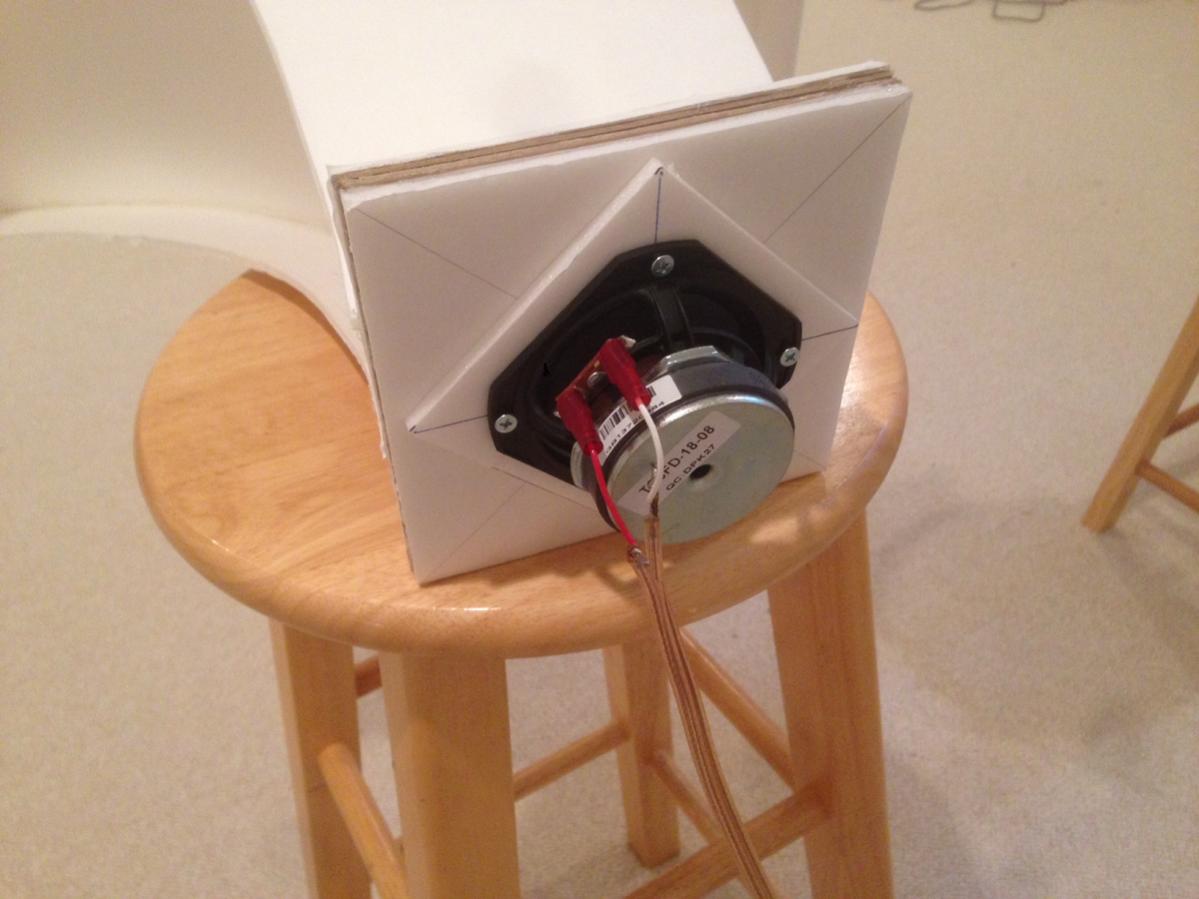
Here is a photo of the finished horn complete with constrained layer damping (CLD) using caulking and a second layer of foam core:
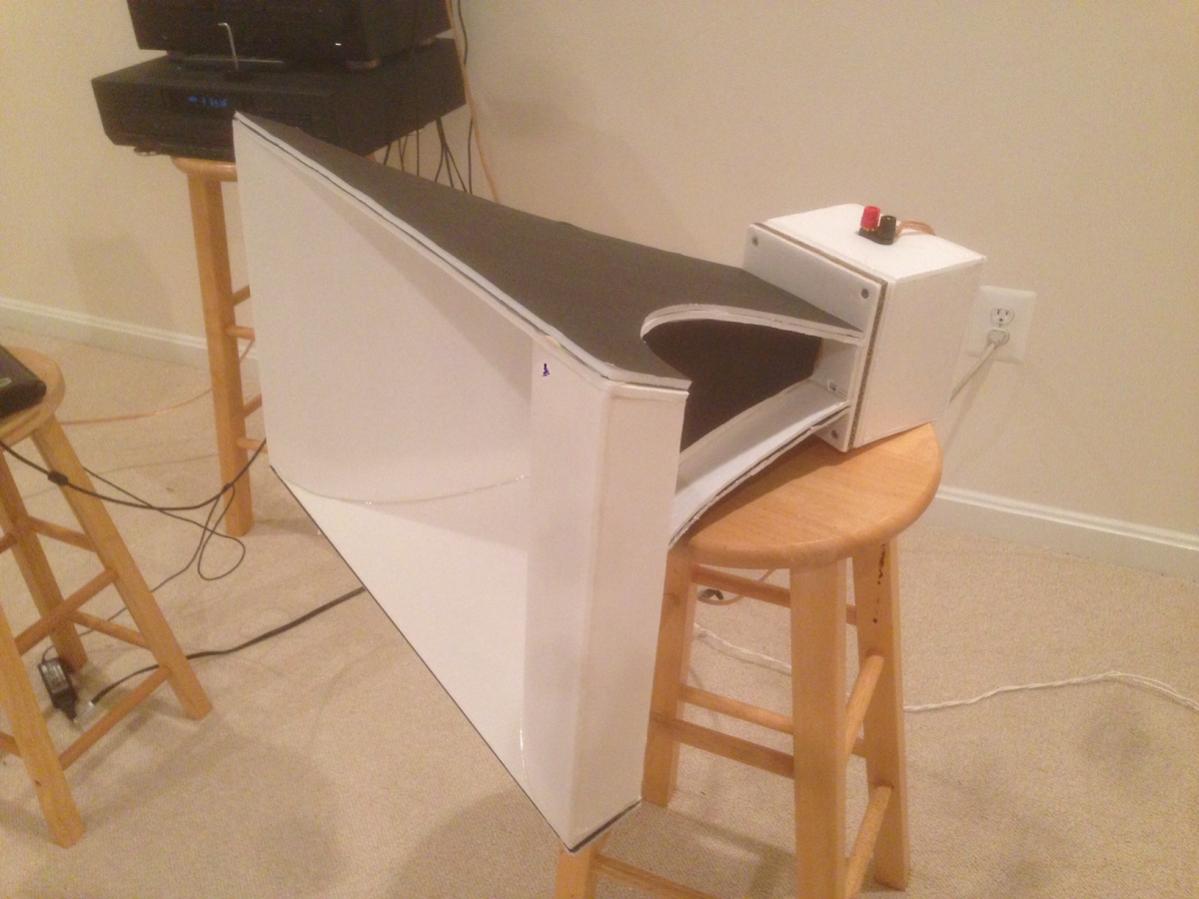
Here is a closeup of the sealed rear chamber (lined with gray open cell foam):
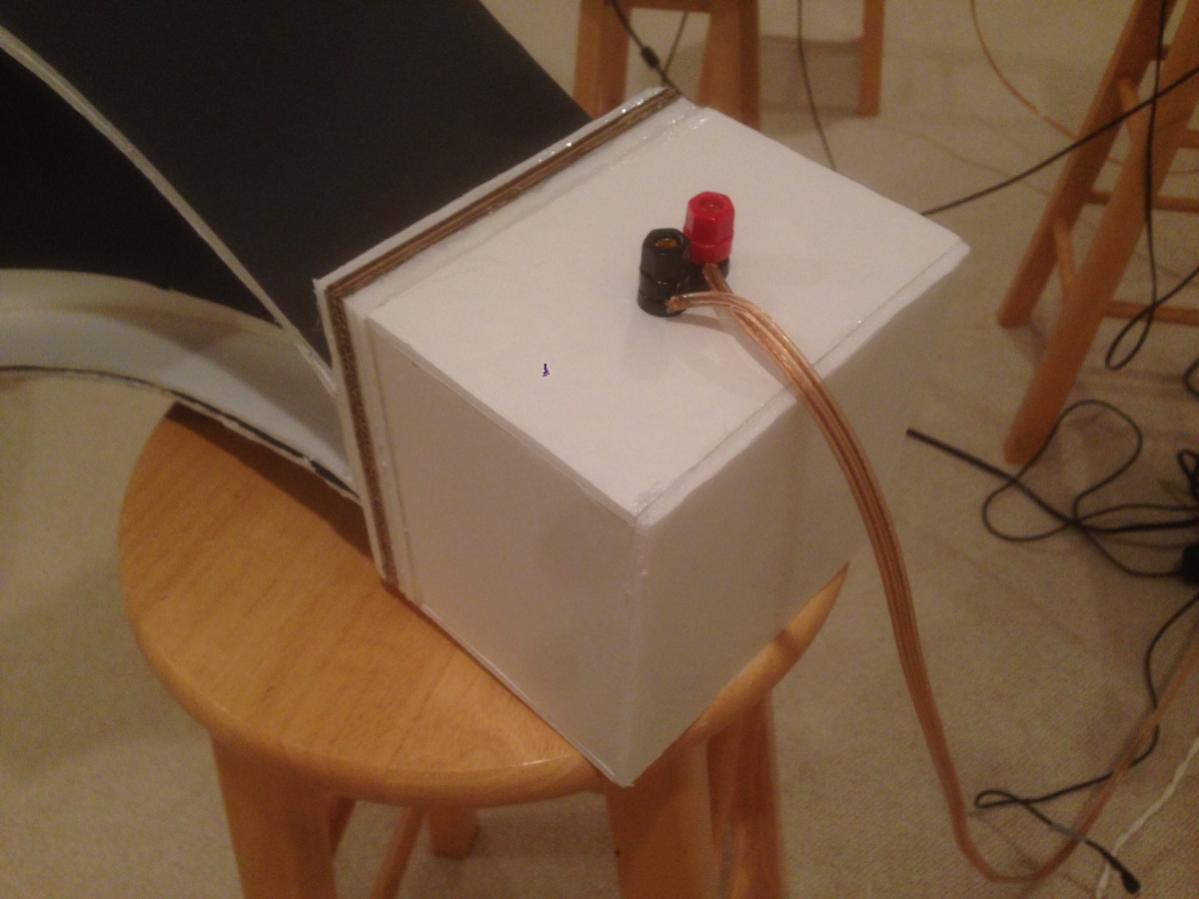
Here is the frequency response and harmonic distortion with the EQ on and a -24dB/oct BW HPF @325Hz. It really surprised me how much HF there is all the way up to 18-19kHz and HD is actually remarkably low:
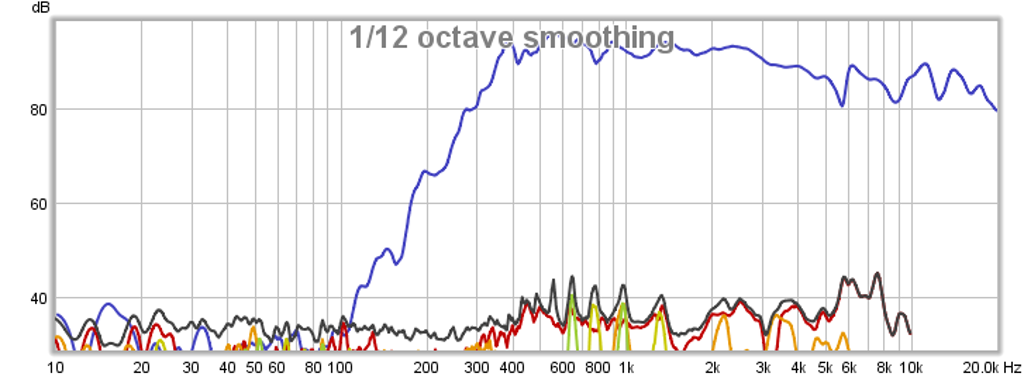
Here is the impulse response of the EQ'd horn:
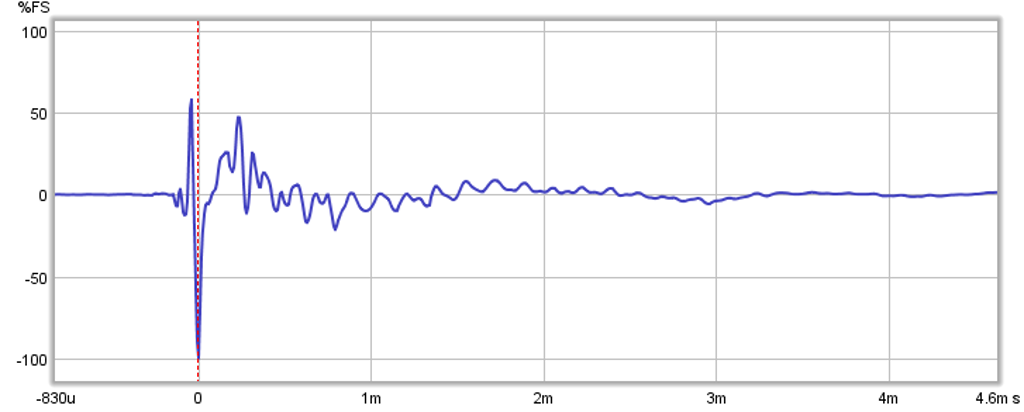
The TC9FD, having a soft, under-damped suspension and a weak motor reacts to the acoustic impedance within the throat and chamber causing many peaks. However, with some EQ'ing, the response can be made to sound quite pleasant. Listening to it, it has the characteristic tractrix horn focus that enhances vocals and intelligibility, and most of all, it is quite loud but still clean and undistorted. I think I gained +10dB in volume after the EQ'ing.
Here are some sound clips to go with it. I think you will agree that the vocals of a Vifa TC9FD in a tractrix horn has a fluid like smooth quality to it.
I threw together another tractrix, this time at 0.70x scale of the first one. The dimensions ended up being 20 in wide x 12 in high x 15.8 in deep with a 1.95in square throat and a 2.3liter rear sealed chamber. Having done the first one provided lessons learned that made this one go very quickly - 4 hrs total. Also, the smaller size made it a lot faster to cut. The design is for a Faital Pro 3FE25, but while waiting for that driver to arrive, I thought why not try out the Vifa TC9FD? It is probably ill suited as a front horn driver with a very soft suspension and a rather weak motor for a high Qts of 0.89. Anyhow, I have them around so I stuck it in for grins. And it turns out not to sound so bad with some EQ'ing.
Here is a photo of the driver mounted onto the throat flange, I had to add a spacer to allow for the rubber half-roll surround to clear the flange:
Here is a photo of the finished horn complete with constrained layer damping (CLD) using caulking and a second layer of foam core:
Here is a closeup of the sealed rear chamber (lined with gray open cell foam):
Here is the frequency response and harmonic distortion with the EQ on and a -24dB/oct BW HPF @325Hz. It really surprised me how much HF there is all the way up to 18-19kHz and HD is actually remarkably low:
Here is the impulse response of the EQ'd horn:
The TC9FD, having a soft, under-damped suspension and a weak motor reacts to the acoustic impedance within the throat and chamber causing many peaks. However, with some EQ'ing, the response can be made to sound quite pleasant. Listening to it, it has the characteristic tractrix horn focus that enhances vocals and intelligibility, and most of all, it is quite loud but still clean and undistorted. I think I gained +10dB in volume after the EQ'ing.
Here are some sound clips to go with it. I think you will agree that the vocals of a Vifa TC9FD in a tractrix horn has a fluid like smooth quality to it.
Attachments
-
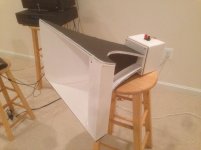 0.7x-tractrix-1.jpg89.9 KB · Views: 19,821
0.7x-tractrix-1.jpg89.9 KB · Views: 19,821 -
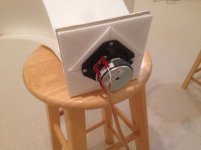 0.7x-tractrix-2.jpg81.2 KB · Views: 20,005
0.7x-tractrix-2.jpg81.2 KB · Views: 20,005 -
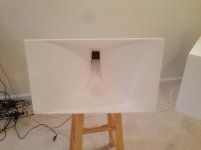 0.7x-tractrix-3.jpg71.3 KB · Views: 147
0.7x-tractrix-3.jpg71.3 KB · Views: 147 -
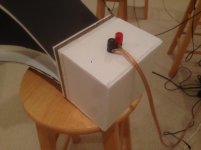 0.7x-tractrix-4.jpg72 KB · Views: 18,946
0.7x-tractrix-4.jpg72 KB · Views: 18,946 -
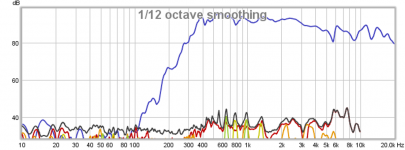 0.7x-tractrix-tc9fd-cld-325hz-hpf.png102.1 KB · Views: 1,377
0.7x-tractrix-tc9fd-cld-325hz-hpf.png102.1 KB · Views: 1,377 -
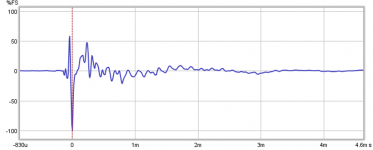 0.7x-tractrix-tc9fd-cld-325hz-hpf-impulse.png44.1 KB · Views: 884
0.7x-tractrix-tc9fd-cld-325hz-hpf-impulse.png44.1 KB · Views: 884 -
Tractrix-0.7x-1.zip960.5 KB · Views: 109
-
Tractrix-0.7x-2.zip890.5 KB · Views: 89
-
Tractrix-0.7x-3.zip862.4 KB · Views: 97
Last edited:
Looks great. Listened the sound clips they good, though i prefer the PRV Tractrix file named "Tractrix-CLD-clip-04", it has a more softness to the sound but so many things when recording can do a difference. Looking forward to your experience with incoming driver you designed for.
Looks great. Listened the sound clips they good, though i prefer the PRV Tractrix file named "Tractrix-CLD-clip-04", it has a more softness to the sound but so many things when recording can do a difference. Looking forward to your experience with incoming driver you designed for.
Well, I would hope the $105 5MR450NDY in a much bigger horn would sound better than a $12 TC9FD in a smaller horn.
Hi
I have downloaded volvotreter sheet and play with it, how do you get on your dimensions? I need also injection ports for two woofers, it be a tractrix synergy two way.
Do you use the 300 hz cutt off? I see in your akabak script it do work nice, special with a cone speaker in stead of a CD driver, give much lower frequenties.
So for me is how to choose the flare cutt of in sheet, I can also put it in hornresp hornresp makes the flare itself, It can do tractrix.
thanks
kees
I have downloaded volvotreter sheet and play with it, how do you get on your dimensions? I need also injection ports for two woofers, it be a tractrix synergy two way.
Do you use the 300 hz cutt off? I see in your akabak script it do work nice, special with a cone speaker in stead of a CD driver, give much lower frequenties.
So for me is how to choose the flare cutt of in sheet, I can also put it in hornresp hornresp makes the flare itself, It can do tractrix.
thanks
kees
Hi
I have downloaded volvotreter sheet and play with it, how do you get on your dimensions? I need also injection ports for two woofers, it be a tractrix synergy two way.
Do you use the 300 hz cutt off? I see in your akabak script it do work nice, special with a cone speaker in stead of a CD driver, give much lower frequenties.
So for me is how to choose the flare cutt of in sheet, I can also put it in hornresp hornresp makes the flare itself, It can do tractrix.
thanks
kees
I use the tab that designs the horn for a square throat based on throat size. I set flare rate at 175Hz and throat at 7.1cm x 7.1cm. The spreadsheet shows horizontal as the flat walls and vertical as the curved walls so you need to flip. This produces quite a large horn (28 in x 17 in x 22 in deep). I found that this large horn is the same size as the 5cm x 5cm throat with a flare rate of 300Hz. Note that with the tractrix, it won't work down to the flare rate, so for the 300Hz case, it is about 400Hz, and for the 175hz case it is about 275Hz. If you really want to build this I can post the profile dimensions I used so you don't have to pull it from the ACAD column. You only need a measurement every inch or so to do this. I would recommend you go with the smaller horn - much more manageable and more suited for the drivers you plan to use. I think the flat/curved tractrix does a good job of reaching a broad bandwidth with a fullrange driver. One just has to accept the limitation that the HF's are generated via cone resonance and not pure pistonic motion. Some of the folks in multiways poo-poo this type of horn but they don't like cone resonance and breakup modes in general. Couple this with a woofer and injection ports and you can have a very simple "2-way FAST Synergy". That is, a Synergy that uses a single full range driver to reach the 400Hz to 20kHz band, and a woofer drivers to fill in below but with the woofer port injected into the horn for a single point source. I should just go ahead and cut some injection ports and screw on some woofers to try. I have some old pro audio 12 in drivers that may work.
Last edited:
New EQ for 0.70x Tractrix w/ TC9FD
Ok, I could not resist playing with the EQ some more, and I admit, this is HEAVY EQ so don't flame me. It is just an experiment to see what it might sound like if I had the right driver.
Here is the new response and harmonic distortion at 0deg. I EQ'd some peaks off-axis to improve the impulse response and smoothness for a more general off-axis case but they show up as dips at zero deg.
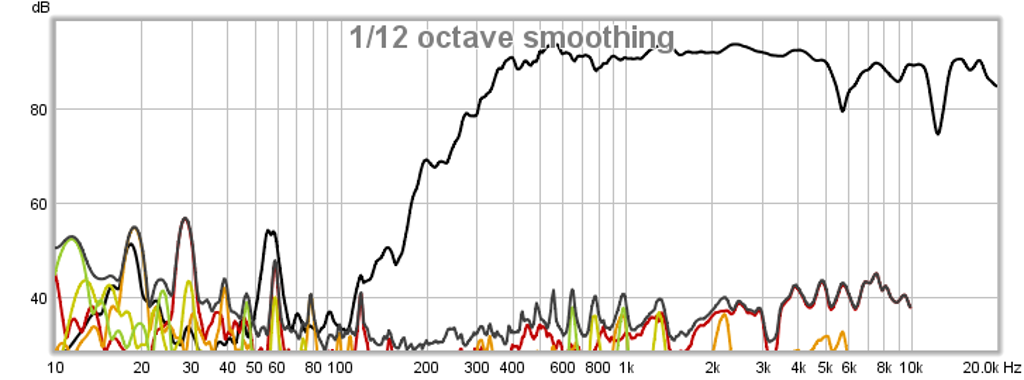
Here is the Polar Response with the new EQ:
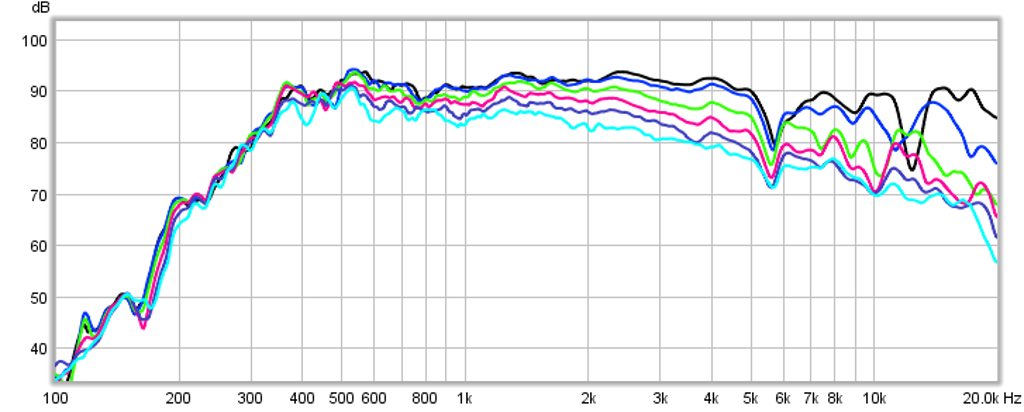
Here is the Impulse Response at 0 deg:
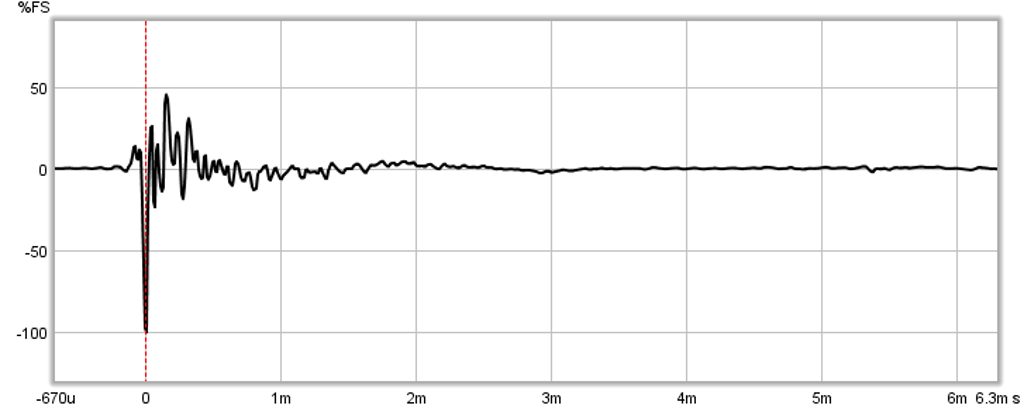
Here is the system response with sub woofer added (24dB/oct BW XO @ 325Hz):
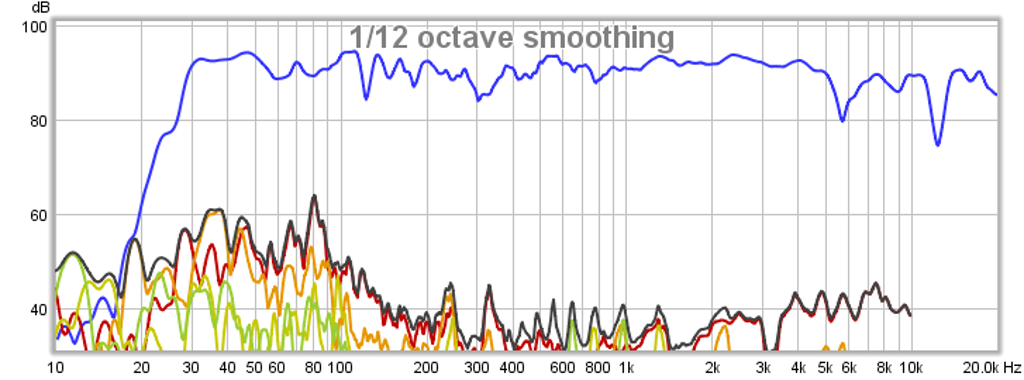
Listening to it, it sounds better - more balanced, less "hollow sounding" and transients on percussion are more crisp.
Ok, I could not resist playing with the EQ some more, and I admit, this is HEAVY EQ so don't flame me. It is just an experiment to see what it might sound like if I had the right driver.
Here is the new response and harmonic distortion at 0deg. I EQ'd some peaks off-axis to improve the impulse response and smoothness for a more general off-axis case but they show up as dips at zero deg.
Here is the Polar Response with the new EQ:
Here is the Impulse Response at 0 deg:
Here is the system response with sub woofer added (24dB/oct BW XO @ 325Hz):

Listening to it, it sounds better - more balanced, less "hollow sounding" and transients on percussion are more crisp.
Attachments
Last edited:
Sound clip of 0.7x tractrix with new EQ
Here is a photo so you can see the difference in size between the fullsize and the 0.70x - it makes a big difference. The smaller one is much more "home friendly".
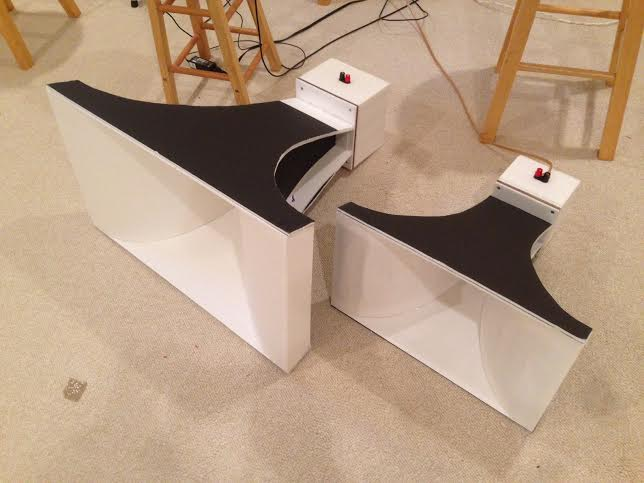
Also, here is a sound clip with the new EQ.
Here is a photo so you can see the difference in size between the fullsize and the 0.70x - it makes a big difference. The smaller one is much more "home friendly".
Also, here is a sound clip with the new EQ.
Attachments
I use the tab that designs the horn for a square throat based on throat size. I set flare rate at 175Hz and throat at 7.1cm x 7.1cm. The spreadsheet shows horizontal as the flat walls and vertical as the curved walls so you need to flip. This produces quite a large horn (28 in x 17 in x 22 in deep). I found that this large horn is the same size as the 5cm x 5cm throat with a flare rate of 300Hz. Note that with the tractrix, it won't work down to the flare rate, so for the 300Hz case, it is about 400Hz, and for the 175hz case it is about 275Hz. If you really want to build this I can post the profile dimensions I used so you don't have to pull it from the ACAD column. You only need a measurement every inch or so to do this. I would recommend you go with the smaller horn - much more manageable and more suited for the drivers you plan to use. I think the flat/curved tractrix does a good job of reaching a broad bandwidth with a fullrange driver. One just has to accept the limitation that the HF's are generated via cone resonance and not pure pistonic motion. Some of the folks in multiways poo-poo this type of horn but they don't like cone resonance and breakup modes in general. Couple this with a woofer and injection ports and you can have a very simple "2-way FAST Synergy". That is, a Synergy that uses a single full range driver to reach the 400Hz to 20kHz band, and a woofer drivers to fill in below but with the woofer port injected into the horn for a single point source. I should just go ahead and cut some injection ports and screw on some woofers to try. I have some old pro audio 12 in drivers that may work.
Thanks, I did post a sim from your script where i did use a phillips driver.
remove all others I have only the bass section simmed, I have put drivers is serie with the nodes. and make the chamber smaller and port smaller (10cm now).
see blue part in ficture.
I do not now what the resonance part of the high speaker will do sound, I needs high quality sound, maybe it is for this part better to co conic synergy who do sim also very good with high reach of the phillips woofers bass sections. see picture two, here I can use a CD driver or a normal tweeter.
By the way sim a tweeter in the port, how to do that best? most, better say all has no thiele small parameters.
change port in your design script to this because of 18 mm thick wood panels here.
BR_dia=6.5*0.0254; | BR port dia inches
BR_len=18.0*0.0254; | BR port length inches
script in zip is only for high driver, everything else is removed and is in 2 parts now, tapped horn is not yet needed and I have own design for this
..
regards
kees
here again.
Attachments
Last edited:
Kees,
The default units in AkAbak are meters which is why I multiply inches by 0.0254. The BR port is a long port for capturing the back wave energy as a bass reflex and redirecting it into the horn mouth. This port is of order 25cm or more. The 18mm thickness you have affects the front chamber injection port. 18mm would be set as 0.018m in the other Len variable not the BR length.
The default units in AkAbak are meters which is why I multiply inches by 0.0254. The BR port is a long port for capturing the back wave energy as a bass reflex and redirecting it into the horn mouth. This port is of order 25cm or more. The 18mm thickness you have affects the front chamber injection port. 18mm would be set as 0.018m in the other Len variable not the BR length.
Kees,
The default units in AkAbak are meters which is why I multiply inches by 0.0254. The BR port is a long port for capturing the back wave energy as a bass reflex and redirecting it into the horn mouth. This port is of order 25cm or more. The 18mm thickness you have affects the front chamber injection port. 18mm would be set as 0.018m in the other Len variable not the BR length.
hehehe yes it is not as easy as it looks, but oke, I have help for it.
I go change it.
Ohh fault, I have put wrong script for bass section above, syn-bass is the right one, synbass.zip belong to the picture here, and is a conic synergy horn the normal way.
regards
Attachments
Last edited:
Yes, I was using a case of it as a PA horn set on poles high above audience for more reach. You have to turn on room reflections and boundaries for that to be used though. It's useful to make it high at first to reduce floor bounce effects them add a more realistic height later. That is why I have back wall at 5000 inches.
- Home
- Loudspeakers
- Full Range
- PRV 5MR450-NDY for FAST/WAW applications
